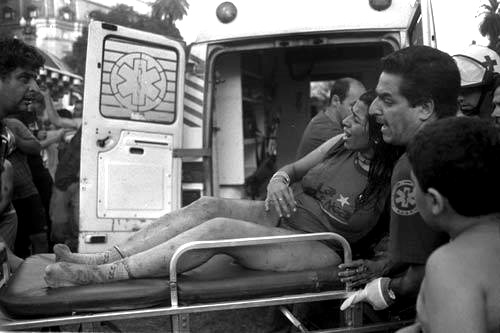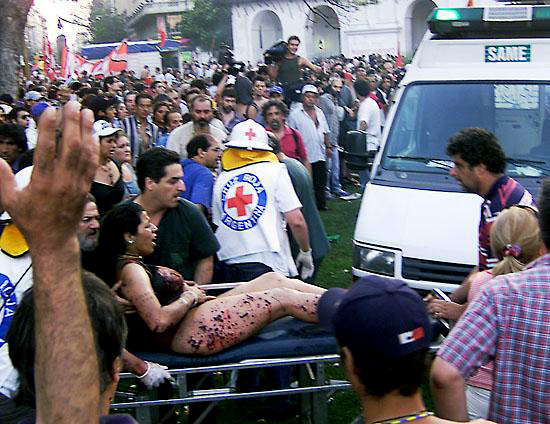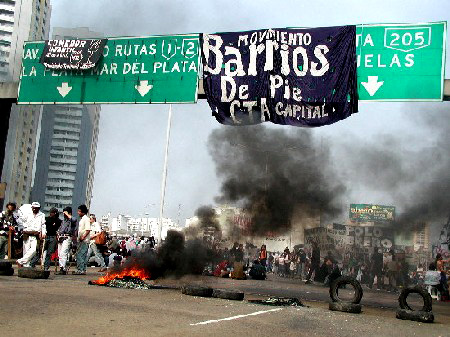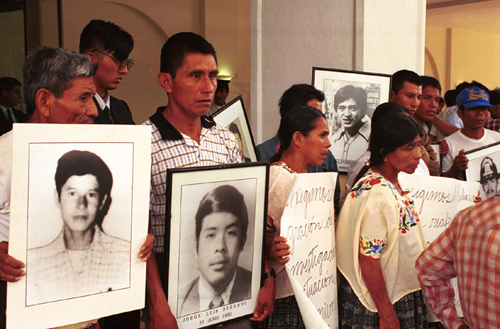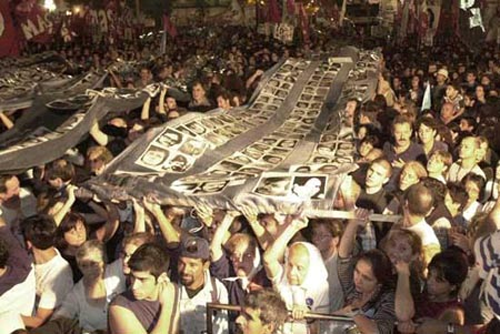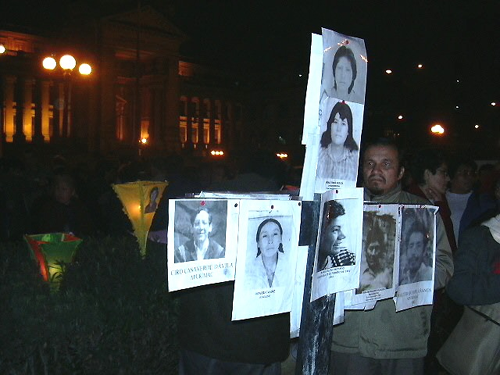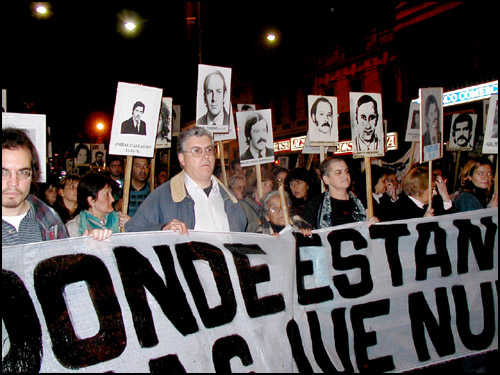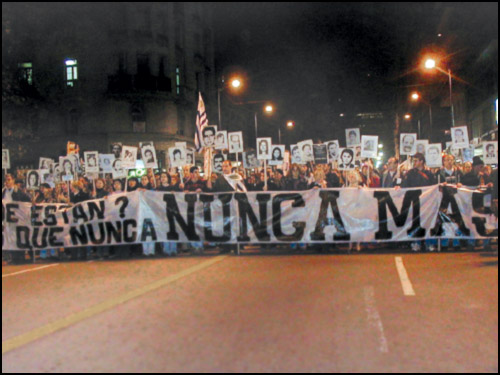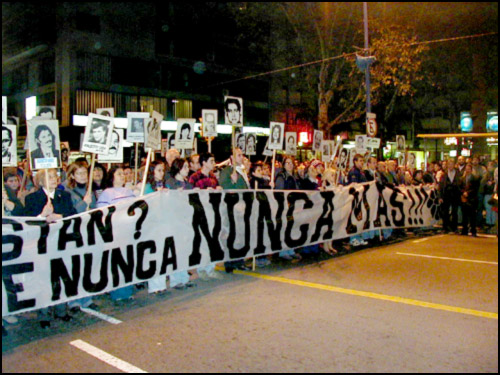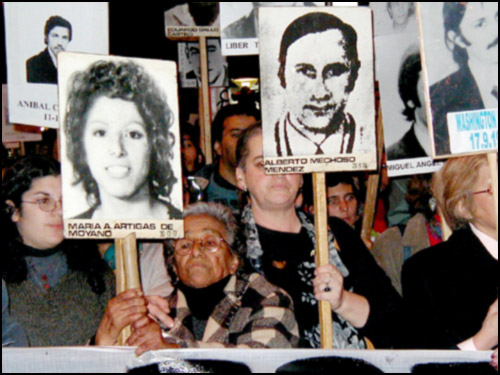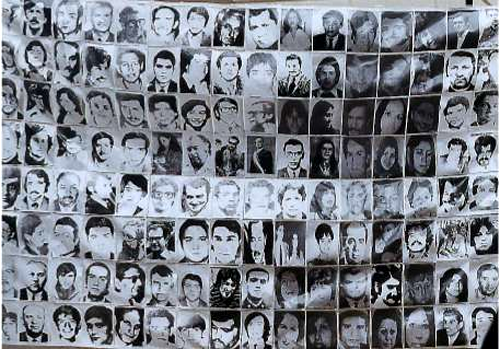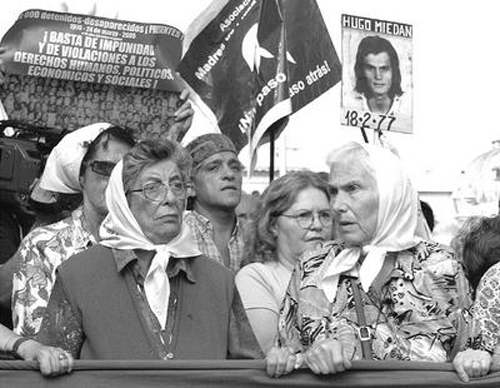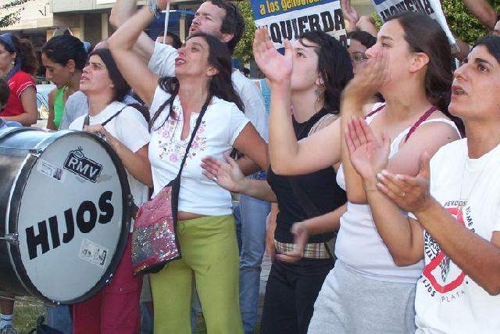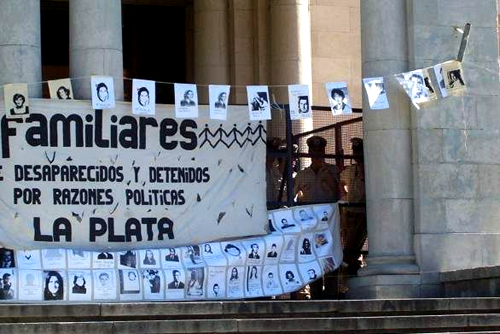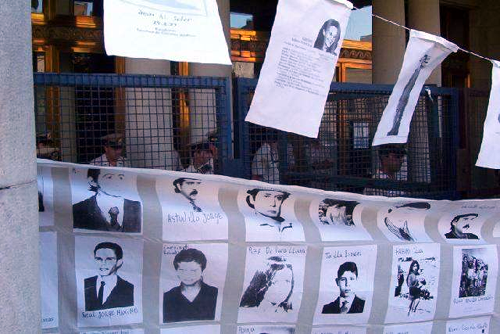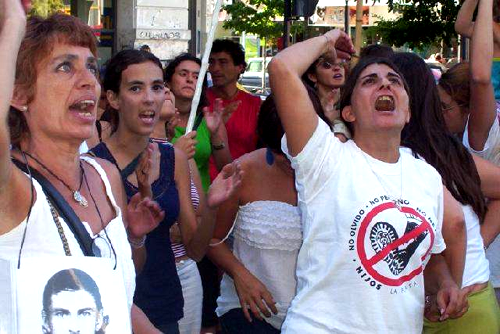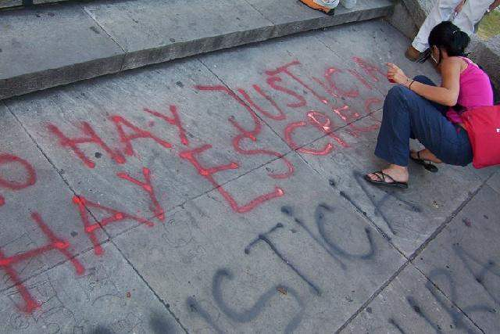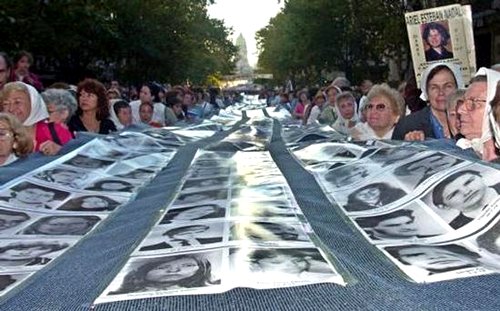|
REALITY IN THE WORLD ARGENTINIAN |
||
|
ENGLISH |
||
|
|
|
|
| . | ||
|
Who are the Piquederos?
----
Desaparecidos... Because...? |
||
| . | ||
|
|
||
|
WHO
ARE THE PIQUETEROS? The increase of the unemployment and the loss of power of the Argentinian
coin produced by the deep economic crisis, have caused a strong increase
of the poverty in the population; this has brought to a progressive loss
of trust in the institutions and in the traditional political parties,
favoring the birth and the growth of groups of opposition that have
given voice and sectors visibility of the population otherwise excluded
by the political life. The protest of these groups, known as"
Piqueteros" has sometimes flowed in violent episodes,
repugnant and naturally to condemn, but that they have been in a which
way" provoked" also from the incapability of the politics to
give answers suitable to this dramatic situation. The movement of the
Piqueteroses is born in 1995 in the south of Argentina as form of
protest against the cut of places of employment in the sector of the
hydrocarbons; but it is in the last years that it's strongly
grown because of the serious economic crisis of the country that has
brought the unemployment to 22%, to the collapse of the banking sector,
to a loss of the power of purchase of the Argentinian coin (-35% in the
solos first 5 months of 2002) and forced the 45% of the population under
the threshold of poverty. To
understand the to rise and the development of the movements of the
unemployed of the last years in Argentina, to understand the new forms
of struggles, las puebladas, the new social and political actors, are
necessary to see the structural transformations more of 25 years of free
trade again. You give first years ninety the working work has suffered a great contortion, losses of the historical conquests of
the workers, growth of the exploitation. Beside to all of this, a level
of expulsion of workers in excesses, that has let the
unemployed become, not more a" manages backup", but in"
surplus populations", million of people that don't have access to
the fundamental rights to exist (to survive). The political class and
the traditional trade-union structures have been accomplices of the
process of delivery and exclusion. As
answered, first in the other provinces and then in the capital and in
the province in Buenos Aires, methods of social resistance are developed
that have given life to new phenomenons of great popular importance. Out
Buenos Aires the struggles take characteristics of true" puebladas."
Whole populations that you/they lived some enterprises of the state (YPF
- oil, Gas of the State, etc) and that when these zones have been made
deprive they transformed him in" people ghost" than without
job, as to it Jumps, Jujuy, Cutral-Co, where the first experiences of
struggle are developed according to the new reality transferring the
fulcrum of the conflict from the factories to the roads. If first it was
tried to paralyse the production (inside the factories) now, in the
territory, it is tried to interrupt the free circulation of the
commodities, with the objective to strike where to the capitalism it
hurts. From Argentina it arrives again to us an example"
constitutive base of the crowd", of embryos more and more developed
of auto social organization, giving life to new devices that have built
new" compositions of resistance and desire, opposite power."
Direct democracy rises up with strength among the new pickets; meetings
popular turns in the jammed roads, the delegates' elections with
revocable orders, the struggle and the based actions on the desire to be
protagonists as only way of arriving to a direct negotiation with the
government. In the whole Country the mobilizations, meetings, permanent
curtains, occupations of public structures," ollas populares"
(popular distribution of food) and the block of roads and the picket,
are above all a faithful mirror of the continuation of the first ones"
puebladas." Other creative forms are added more recently,
picchettere to the struggles: the" caserolazos" of the middle
class in the great cities and the occupation of factories that produce
through the cooperation and the control worker, and that together, with
their convergence of objectives, they have made to enter crisis (and
to fall) more than a government, as has happened 19 and December 20 th
2001, when the inhabitants of Buenos Aires poured again him in the roads
and in the plazas, forcing to the escape the President, and after the
Massacre of Avellaneda in June 2002, when they murdered the companions
Dario Santillan and Maximiliano Kosteki. PIQUETEROS I enlivens
piqueteros that is born in the whole country, they rise up in different
way and they are structured in more organizations and tendencies. Does someone stop him to think
who am and what are in reality the piqueteroses? It would everything be enough to remember, that they are Human beings that
have the right as all to a dignified life. And that this possibility was
removed to them by the scoundrels that became wealthy thanks to
the exploitation of other people's sacrifice. The piqueteroses are
People, they have family, they have children, they love, they dream, and
they have necessity fundamental and other anchor. Well, these necessities Are not
Satisfied, and not for their guilt. Among
the organizations that have maintained a permanent conflict with the
corrupt and repressive politics of the last years there are the direct
ones and supported by the parties of left and then those that as the MTD
(Movement Idle Workers) of Solano, they also vindicate full
autonomy towards the parties of official left. All these realities have
given in common a great appointment of struggle converging in the most
important objectives and in the most greater battles of the last years. The Movement Piquetero MTD And' the mirror
of the struggles of the last years, of the trial to recompose all the
popular strengths and the resistances in Argentina. The
piquete is very more of the court de ruta (street block), it is the
visible portion of an alternative society that fights and works
with seriousness and responsibility to create an alternative to the
capitalism, that cannot rise that from the base from the self-government
of the communities, through the resistance and the creation of a new
world here and now. They are men and women that are exchanging the place
assigned them by the tall one, with an anything else other than
themselves have created from the lower part. It deals with the autonomy
of the rebellion and to rise up to the order and the imposed power. The
existence of spaces permanent auto checked, allows the MTDs to create
integral forms of life, that embraces the health, the education, up to
the production and to the idleness. It deals with an aspect that
differentiates the movement piquetero from all the others and that it
creates the potentialities to admit auto social organization. |
||
| .
. |
||
| . | ||
|
THE TESTIMONIES OF THE PIQUETEROS |
||
| . | ||
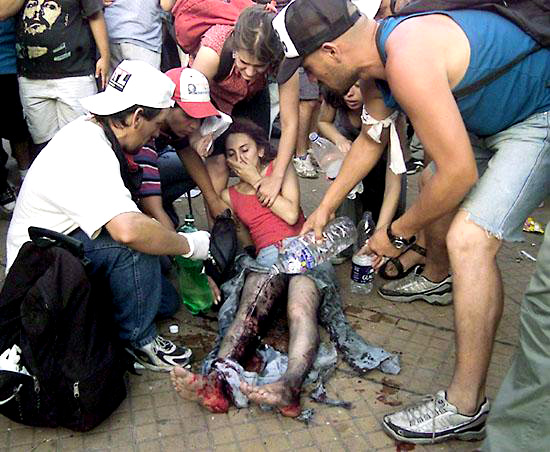 |
||
| Our struggle and our political-social activities found him on three elementary aspects of the human way of living: Job; Dignity'; Social Change. Job: because it is what it comes wildly denied and what pretends as inalienable right, because despite the unemployment we feel there part of the category of the workers. Dignity': because without dignity there is not future. Because despite the difficulties, we don't surrender there of it' there we subdue, maintaining us standing without begging alms and charity from those people whom are responsible of the situation of poverty that we live. Because we have inherited the dignity of the historical struggles of our ancestors that you/they keep on living as the flag of the future of our children; in a country where the primary rights as the job, the health, the education, the house, the feeding, the suits, the liberty to get organized and to express is respected. Social change: because this worthy future will have to build him on a correct society and of equality, and for all of this it will be had to transform from the root this system, ending once and for all with the exploitation of the man sull' man, with the dominion and the alienation. This social change is expressed in the new relationships and forms of organization that we are building out some logic of the capitalistic system, and it is projected toward the future, in the need to expand and to intensify the people struggles in a transformation social radical. | ||
| .
. . |
||
|
|
||
| Today in Latin America, they want to convince us that can exist good governments that want to save us from the imperialism, hoisting the flags populist of a more human capitalism. They don't interest us presidents and governments that put on of accord among them, that treats with our lives. We trust only there our strengths and we don't have any intention to give our potentiality. | ||
| .
. . |
||
|
|
||
| The
privatization of the Argentinian oil resources and their delivery to the
firms private foreigners has meant for these last the
attainment of huge fortunes; but for hundreds of thousand of Argentinian
families these provisions have provoked poverty and unemployment. |
||
| .
. . |
||
|
|
||
| The
continuous road blocks in which the hard line of the piqueteroses
consists express the refusal of the politics and the institutions
corrupt persons responsible of the poverty of Argentina. The government
is making a strong pressure to persuade the public opinion that the
piqueteroses are potentially violent and therefore they doesn't have the
right to protest. |
||
| .
. . |
||
|
|
||
|
Piquiteros
with a poster… allusive to the espionage of the Government. |
||
| .
. . |
||
|
|
||
|
Piquiteros in the Plaza of May, in front of the town Board in Buenos Aires. |
||
| .
. . |
||
|
|
||
| .
. . |
||
|
DESAPARECIDOS Because...? |
||
| . | ||
|
|
||
| Among 1976 and 1983 in Argentina 30 thousand citizens disappeared: political opponents, intellectual, students, syndicalists, workers, religious and even children. All these people were illegally seized, you torture, killed and made to disappear in the nothing. The repression belonged to an illegal plan but predestined and systematic, performed from military to the orders of the tallest commands of the armed forces of the country. | ||
|
|
||
| In Argentina the repression was conducted in organized way. The soldiers to the power didn't repeat the errors of Pinochet, that immediately after the coup d'état it gathered thousand of opponents in the stadium of Santiago of Chile: the images of a field of kick turned into enormous sky opened lager made the turn of the world and they provoked a strong reaction of the international public opinion. In truth the dictatorship of Pinochet was not even one of the cruellest: in Paraguay Stroessner also made worse things but he/she remained in power thirty years and his/her name it is practically unknown to the great public. | ||
|
|
||
| The
fact is how very thick also the great journalistic signatures introduces
the dictators as Videla or Pinochet as of the perverse ones, thirsty
beasts of blood. And' a wrong thing, doesn't need to stay himself/herself/themselves
to the appearance. And' true that for instance the general Galtieri
(head of the Argentinian military junta from 1980) it was indeed a
drunkard and a pervert, but it is not the essential thing. Behind
Galtieri, behind Videla, there was no perversion, but of the well clear
projects, structured. The true reasons are not in the cruelty of the
single individuals, they are in the economic affairs. |
||
|
|
||
| Thirty
years ago in Latin America there were Countries that enjoyed of a strong
autonomy and of solid economies. Particularly Argentina was a strong
country, endowed with an advanced social state (the illiteracy, one
century had for instance, been defeated before) and of enormous natural
resources all, in public hand: oil, coal, petrochemical, electric energy,
without counting the whole system of the transports and the railroads. |
||
|
|
||
| The plan of reform of the military junta that went to the power in 1976 contemplated to the disintegration of the national economy in the optics of a project of privatizations that you/they would have favored not the national affairs but those of foreign private investors and of the great multinational companies. The repression was functional to this project and aimed to preventively eliminate every possible opposition. The necessity to fight the terrorism, alleged by the soldiers during the trials as principal reason for the repression, it was only a pretext, since the guerrilla was absolutely in Argentina a limited phenomenon: according to the sources of the CIA the armed organizations could count at the most on 350 fighters. In effects, thing can count 350 people in a Country of 30 million inhabitants: practically nothing! Then these organizations guerriglieres were not so dangerous then for the power. In substance, a whole generational band was struck, harshly particularly certain professions, to preventively prevent every development of the popular organizations. You treated therefore of a based political plan on a project of economic control. | ||
|
|
||
| The
opponents were seized to their house, to school or on the place of job
from one" patota" of soldiers in bourgeois. The seized one was
hooded and thrown on the floor of the auto. Then the torture. The used
tool was the electric picana, a very simple tool, easy to build, that
can work with the tide to 220 volts or with a battery as that of an
automobile. |
||
|
|
||
| It
consists in an auto transformer, available in any shop of electric
material, in which the few volts of the battery or the 220 of the
electric net enter and on the other side they go out 6, 8, 10 thousand,
15 thousand volts. To the exit there handle is and separate two
electrodes on the point, used for burning the skin and the meat. You/they
macaws used in the vagina, on the testicles, on the penis, on the
breasts, on the gums and on the eyes. And' one of the methods also
applied in thick way because could immediately be used already on the
automobile after the sequestration: |
||
|
|
||
| From
the moment in which the sequestration the person happened totally stayed
isolated by the external world. Deposited in one of the numerous
concentration camps or in intermediary places of detention where you was
submitted to infernal tortures. |
||
|
|
||
| In this way thousand and thousand of people gave form to the ghost category of the desaparecidoses. Any question found an answer: the police had not seen anything, the government pretended not to understand of what he was speaking, the Church was not pronounced, you list him of the jails they didn't record their detentions, the judges didn't intervene. Around the desaparecidoses had gotten up to wall of silence. | ||
|
|
||
| But
because a dictatorship with an overwhelming military strength has chosen
as strategy that to let over 30.000 opponents to disappear? Because
after the torture and the inhuman imprisonment these people have not had
at least the right to a death sentence? Because they have not been
buried, because the destruction of the bodies? Because
desaparecidos? |
||
|
|
||
| Doesn't
is not answer there that can explain this intentional violation of every
right of the person. In front of these atrocities every logic ten,
becomes inhuman, and when a logic becomes inhuman it is not more logical.
|
||
|
|
||
|
Objective
strategic some military project was the destruction of the past. Because
if the past didn't exist, in that particular form of existence that is
the not to be already it, the present it would not exist and the future
to project him would not even miss the possibility. |
||
|
|
||
| In
Argentina the repression has been conducted in scientific way, studying
the reactions of the people: the sessions of torture were followed by a
physician to avoid that the prisoners died before confessing, while the
methods of questioning applied the indications of a équipe of
psychologists. And' also verified the presence
of military chaplains that you assisted to the torture. |
||
|
|
||
| From
1976 to 1983 in Argentina 340 fields of clandestine detention worked,
fairly left again among army and military harbor, that had established
to divide the assignments: the Marxist left was repressed by the army,
while the harbor occupied him of the peronist left and of the
montoneroses, I confined in smaller fields of detention as the notorious
one" Olimpo." The greatest concentration camp was that Field
de Mayo, an enormous barracks, managed by the army: we know even that
here the bodies were preserved embalmed of three heads guerrilleros,
with their suits and the original weapons. This museum of the horror,
prepared inside the barracks has been made to disappear from the
soldiers to the return of the democracy, and he/she anchors today it is
ignored that end has done the" finds" exposed. |
||
|
|
||
| In
places as this they tortured the prisoners for two or three months, then
they killed them or they insisted with the torture up to provoke its
death, or they left them to die without any type of medical assistance.
The bodies came buried in it was common, burnt or cripples to avoid its
recognition; hundreds they were also the narcotized prisoners and thrown
in sea you live from the military airplanes. At times the soldiers did
in way of doing find again some unrecognizable dead bodies or even they
freed some imprisoned to the purpose to make to slip out some news and
to create in the society a climate of terror. |
||
|
|
||
|
In Argentinian he disappeared twice, first
from alive and then from dead. You esteems that among the' 76 and the 83 were destroyed around 30000
people.
30.2% workers 21%
students 17.9%
employed 10.7%
professionals 5.7%
teachers 5%
autonomous workers 3.8%
housewives 2.5%
soldiers of lever, police officers 1.6%
journalists 1.3%
artists 0.3%
religious What was finished in Argentina has been an ideological Genocide. |
||
| . | ||
| The
realization of these articles has been possible graces to the
collaboration of some friends of mine Argentinian journalists, that have
given me the possibility to make a reconstruction of some social
phenomenons that an indelible sign has left in the history of the
humanity. through their precious documentation -
Piero C. |
||
| . | ||




